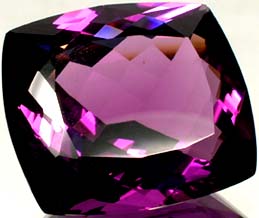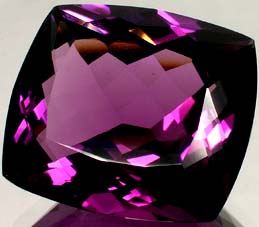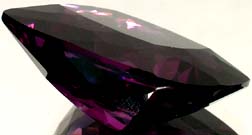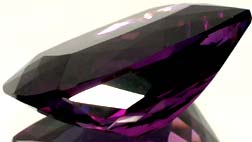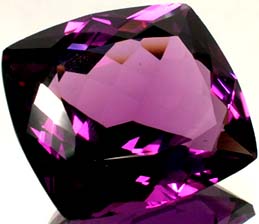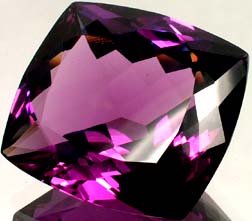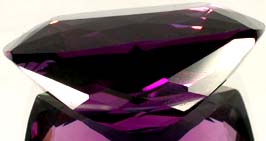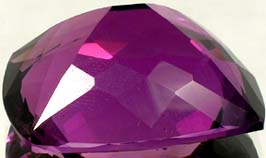| 19thC Antique Handcut Natural 56ct Amethyst Scotland 28mm*25mm - $599.99
For Customers outside of USA 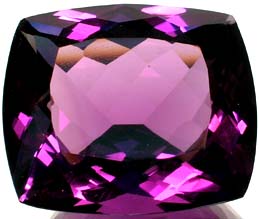
Antique 19th Century Handcrafted Natural Fifty Six Carat Amethyst from Scotland (Handcrafted in Russia). GEMSTONE ORIGIN: Coastal Devonian Lava Beds, Angus, Scotland. 19th Century.
SIZE: Length: 28mm. Width: 25mm. Depth: 13mm. All measurements approximate. WEIGHT: 55.95 carats. NOTES: Upon request we can set your gemstones as a ring, pendant, or as earrings.
DETAIL: Most ancient Mediterranean cultures, including the ancient Romans, Greeks, and Celts believed that amethyst would protect against becoming intoxicated, and would protect soldiers from harm in battle. Legend attributes the Amethyst's lovely color to the Greek God Bacchus (the god of wine). Here's a very large, very clean, 19th century faceted amethyst oval from the Devonian lava beds found along the coast of Angus Country, Scotland. Exported to Russia, the gemstone was hand crafted and faceted by a 19th century Russian artisan, part of an heritage renown for the production of the elaborate gemstones and jewelry of the Czars of Medieval, Renaissance, and Victorian Russia. Very popular in 18th and 19th century Victorian Scotland, amethyst has remained a very popular gemstone through the 20th century. This is a very fine richly hued, regally textured deep purple colored semi-precious gemstone. .It was hand cut into a sparkling, brilliant, faceted “old-fashioned” cut gemstone with lots of flash and depth. The cut is also known within the trade as a “cushion”.
As you can see from the photo enlargements here, it is to the eye completely transparent and free from inclusions, and possesses exceptional sparkle and luster. It is very clean, water clear, and very bright with brilliant sparkles. Under magnification the gemstone shows the unmistakable characteristics of having been hand crafted. The coarseness of the 19th century finish is considered appealing to most gemstone collectors, and is not considered a detriment, or detract from the value of a gemstone. These characteristics are not only expected of hand-finished gemstones, most serious collectors consider such gemstones more desirable, possessed of greater character and uniqueness when compared to today's cookie-cutter mass-produced machine-faceted gemstones. Unlike today’s computer controlled machine produced gemstones, the cut and finish of a gemstone such as this is the legacy of an artisan who lived two centuries ago.
This gemstone has great luster and sparkle, and to the eye is completely transparent, but it is not absolutely flawless. True, any blemishes it possesses are not visible to the naked eye, and even at 500% as in these photo enlargements here (or under a 5x jeweler’s loupe) there are no discernible flaws. However we hesitate to use the word “flawless”, as sooner or later blemishes will show up at higher levels of magnification with almost every natural gemstone. An absolutely flawless gemstone is very rare in nature (and usually turns out to be synthetic). However the gemstone can be characterized at a minimum, to use trade jargon, as "eye clean". To the eye it is indeed flawless; and even to a jeweler’s loupe it is difficult to find any imperfections. However close examination with a jeweler’s loupe will however reveal occasional blemishes within the gemstone (as is the case with most any natural gemstone), as well as slight irregularities in the faceting and finish. Of course these characteristics are to be expected of antique, hand-finished gemstones. However for most, the unique nature and character of antique gemstones such as this more than makes up for any minor blemishes or faceting imperfections which by and large, are (if at all) only visible under high magnification.
HISTORY: Amethyst was one of the first gemstones used by man. The name is derived from the Greek term "amethustos", meaning not drunk. Amethyst came to Greece from Egypt just after the death of Alexander the Great. Most ancient Mediterranean cultures believed that amethyst would protect against becoming intoxicated, and would protect soldiers from harm in battle. Throughout ancient and medieval history, the color purple was traditionally the color of royalty. Consequentially Amethyst has been used since the dawn of recorded history to adorn the wealthy, as well as royalty, and was extensively used since ancient times for carving intaglio gemstones and seals. Amethyst is also mentioned in the Bible (Exodus 28:19; 39:12) as one of the 12 stones adorning the breastplate (hoshen) of the high priests of Yahweh.
Amethyst is the most highly valued variety of quartz. The purple coloring is caused by the presence of compounds of iron or manganese. Aside from the gorgeous color, Amethyst is also very popular in the production of jewelry due to the fact it is very hard and durable. Some of the other popular varieties of quartz include rock crystal (colorless quartz), citrine (yellow quartz), and aventurine (green quartz). Amethyst, like all quartz crystals, produces an electric voltage, a property known as piezoelectric. Unable to understand the characteristic, ancient cultures attributed many mystical properties have been attributed to the various varieties of quartz gemstones. Quartz gemstones were believed to act as psychic purifiers, tuning one into their inner "vibrations". It was believed that quartz possessed the ability to amplify emotions, enhance concentration and intuition, and neutralize "negative energies".
SHIPPING OPTIONS: All purchases are backed by an unlimited guarantee of satisfaction and authenticity. If for any reason you are not entirely satisfied with your purchase, you may return it for a complete and immediate refund of your entire purchase price. Most of these antique gemstones were originally part of two collections, one originating in India principally composed of gemstones originally mined in India, Burma, Ceylon, and Siam, and then hand faceted in India. The addition of a second accumulation of antique gemstones originally mined in the Urals in the mid to late 19th century (including alexandrite) completed the collection. These gemstones as well were hand finished. The Urals have been one of the world's major sources of precious and semi-precious gemstones for many centuries. As well, additional specimens are occasionally acquired from other institutions and dealers in Eastern Europe and Asia. These antique gemstones are now in the United States and are available for immediate delivery. We ship inventory from the USA order fulfillment center near Seattle, Washington. Your purchase will ordinarily be shipping within 48 hours of payment. A certificate of authenticity is available upon request. We prefer your personal check or money order over any other form of payment - and we will ship immediately upon receipt of your check (no "holds"). We will accept PayPal payments. Please see our "ADDITIONAL TERMS OF SALE".
|
|---|
